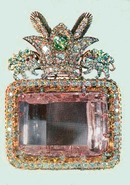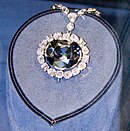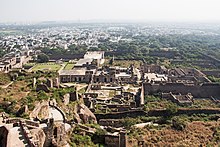
గొల్కోండ కోట రాష్ట్ర రాజధాని అయిన హైదరాబాద్ నగరానికి 11 కిలోమీటర్లదూరంలో ఉంది.ఈ ప్రాంతాన్ని క్రీ"శ 1083 నుండి 1323 వరకూ కాకతీయులు పరిపాలించారు. గోల్కోండ అసలుపేరు గొల్ల కొండ.దీనికి ఈ పేరు రావడానికి చిన్న కధ ఉంది.ఇక్కడ గొర్రెలు కాసుకునే గొర్రెలకాపరికి మంగళవారం అనే కొండపై దేవతావిగ్రహం కనపడిందంట.ఈ విషయాన్ని కాకతీయరాజులకు చెప్పగా ఇక్కడ మట్టితో ఒక కట్టడం నిర్మించారట.కాలక్రమంలో గొల్లకొండ గొల్కోండగా రూపాంతరం చెందింది.చాలాకాలంవరకూ ఇది కాకతీయుల అధీనంలో ఉండేది.అయితే యుధ్దసమయంలో సంధిలో భాగంగా 1371లో గోల్కోడ కోట అజీం హుమాయూన్ వశమయ్యింది.దీనితో ఈకోట మహ్మదీయిల చేతిలోనికి వెళ్ళింది.తరువాత కాలంలో అనేక రాజుల చేతులు మారి 15న శతాబ్ద సమయంలో కుతుబ్ షాహీ రాజుల చేతులోకి వెళ్ళగా వారు ఇక్కడ ఇప్పుడు మనకు కనిపించే నల్లరాతి కొటను కట్టించారు.తరువాత కుతుబ్ షాహీ వంశస్తులను ఔరంగజేబు జయించి ఈకోటను కొంతభాగం వరకూ నాశనం చేశాడు.దీనితో ఇక్కడ పాలన కాలగర్బంలో కలిసిపోయింది.
ఈకోట ప్రస్తుతం ఎంతో చరిత్రను తనలో ఇడుమడింపచేసుకుని బావితరాలకు సజీవ సాక్ష్యంగా నిలుస్తుంది.ఈకోటను 120మీటర్లు ఎత్తుకలిగిన నల్లరాతికొండపై నిర్మించారు.గోల్కోండను శత్రువుల నుండి రక్షించుటకు దీనిచుట్టూ పెద్దబురుజును నిర్మించారు.ఇది 87 అర్దచంద్రకార బురుజులతో 10 కిలోమీటర్లు కొట చుట్టూ కట్టబడింది.ఈకోటలో నాలుగు ప్రధాన సిమ్హద్వారాలు,అనేక రాజమందిరాలు,దేవాలయాలు,మసీదులు కలవు.కోటలోనికి శత్రువులు ప్రవేశిచినపుడు పైవారికి సమాచారము చేరవేయుటకు ధ్వని శాస్త్రము అధారంగా అద్భుతంగా నిర్మించారు.ఇక్కడ నుండి చప్పట్లు కోడితే కిలోమీటరు దూరంలోని కోట లోపల ఉండే బాలా మిస్సారు వద్ద ఈ శబ్దం చాలా చక్కగా వినపడుతుంది.ఇక్కడనుండి కోటలోనికి చేరుకోవడానికి 380 రాతిమెట్లు కలవు.కొటలోనికి నీటిని అప్పటిలోనే ప్రత్యేక విధానం ద్వారా పైకి చేరవేసేవారట.ఈకొటలోనుండి నగరంలో ఉన్న చార్మినార్ కు గుర్రం పోయేటంత సొరంగమార్గం ఉందని ప్రచారంలో ఉంది.
ఈ కోటలో కాకతీయులచే నిర్మించబడిన ప్రాచీన దేవాలయాలు కలవు.వీటిని పాతకాలం నాటి గండశీలతో నిర్మించారు.అంతే కాకుండా ఈ కోటలోనే శ్రీరామదాసుగా పిలువబడే కంచర్లగోపన్నను భద్రాచలంలో రామాలయం నిర్మించినందుకు తానిషా కారాగారంలో భందించాడు.ఈ కారాగారంలో రామదాసుచే గోడలపైన చెక్కబడిన సీతారామ,లక్ష్మణుల విగ్రహాలను చూడవచ్చు.హీందూ దేవాలయాలతో పాటు అనేక మసీదులు కూడా కలవు.
ఈ భావితరాలకోసం పరిరక్షించుటకు దీనిని పురావస్తుశాఖవారు రమ ఆధీనంలో పరిరక్షిస్తున్నారు.కోటను చూడటానికి ప్రతిరోజు ఎంతోమంది సందర్శకులు దేశ విదేశాలనుండి వస్తారు.వారి కోసం అలనాటి కోట విశేషాలు తెలియచెప్పే సౌండ్ అండ్ లైట్ షో ఏర్పాటుచేయబడుతుంది.దీనిని తెలుగు,హిందీ,ఇంగ్లీషు భాషల్లో ప్రదర్శిస్తున్నారు.
షో ప్రదర్శించు సమయాలు -
ఇది నవంబర్ నుండి ఫిబ్రవరి వరకూ సాయంత్రం 6.30కు మొదలవుతుంది.మార్చినుండి అక్టోబర్ వరకూ 7గంటలకు స్టార్ట్ అవుతుంది.ఈ షో మొత్తం 55ని"లు ఉంటుంది.
ఇంగ్లిషులో - బుధవారం మరియు ఆదివారం
హిందీలో - గురువారం,శుక్రవారం మరియు శనివారం
తెలుగులో -మంగళవారం
సోమవారం ప్రదర్శనకు సెలవు.
english
Under the Bahmani Sultanate, Golkonda slowly rose to prominence. Sultan
Quli Qutb-ul-Mulk (r. 1487–1543), sent as a governor of Telangana, established it as the seat of his government around 1501. Bahmani rule gradually weakened during this period, and Sultan Quli formally became independent in 1538, establishing the
Qutb Shahi dynasty based in Golkonda.Over a period of 62 years, the mud fort was expanded by the first three Qutb Shahi sultans into the present structure, a massive
fortification of granite extending around 5 km in
circumference. It remained the capital of the Qutb Shahi dynasty until 1590 when the capital was shifted to
Hyderabad. The Qutb Shahis expanded the fort, whose 7 kilometres (4.3 mi) outer wall enclosed the city.
The fort finally fell into ruin in 1687, after a year long siege leading to its fall at the hands of the
Mughal emperor
Aurangzeb.
Diamonds
The Golkonda Fort used to have a vault where once the famous
Koh-i-Noor and
Hope diamonds were stored along with other diamonds.
Golkonda is renowned for the diamonds found on the south-east at
Kollur Mine near
Kollur, Guntur district,
Paritala and Atkur in
Krishna district and cut in the city during the
Kakatiya reign. At that
time, India had the only known diamond mines in the world. Golkonda's mines yielded many
diamonds. Golkonda was the market city of the diamond trade, and gems sold there came from a number of mines. The fortress-city within the walls was famous for diamond trade. However,
Europeans believed that diamonds were found only in the fabled Golkonda mines. Magnificent diamonds were taken from the mines in the region surrounding Golkonda, including the
Daria-i-Noor or "Sea of Light", at 185 carats (37.0 g), the largest and finest diamond of the
crown jewels of
Iran.
Its name has taken a generic meaning and has come to be associated with great wealth.
Gemologists use this classification to denote a diamond with a complete (or almost-complete) lack of
nitrogen; "Golconda" material is also referred to as "2A".
Many famed diamonds are believed to have been excavated from the mines of Golkonda, such as:
By the 1880s, "Golkonda" was being used generically by English speakers to refer to any particularly rich mine, and later to any source of great wealth.
The Fort
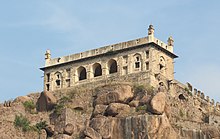
The Baradari at the top of the citadel
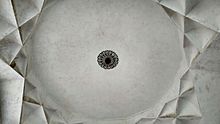
Architecture inside golkonda fort
The Golkonda fort is listed as an archaeological treasure on the official "List of Monuments" prepared by the
Archaeological Survey of India under The Ancient Monuments and Archaeological Sites and Remains Act. Golkonda actually consists of four distinct
forts with a 10 km long outer wall with 87 semicircular bastions (some still mounted with
cannons), eight gateways, and four
drawbridges, with a number of royal apartments and halls,
temples,
mosques, magazines, stables, etc. inside. The lowest of these is the outermost
enclosure into which we enter by the "Fateh Darwaza" (Victory gate, so called after
Aurangzeb’s triumphant
army marched in through this gate) studded with giant
iron spikes (to prevent
elephants from battering them down) near the south-eastern corner. At Fateh Darwaza can be experienced a fantastic
acoustic effect, characteristic of the
engineering marvels at Golkonda. A hand clap at a certain point below the
dome at the entrance reverberates and can be heard clearly at the 'Bala Hisar'
pavilion, the highest point almost a kilometer away. This worked as a warning note to the royals in case of an attack.
The whole of the Golkonda Fort complex and its surrounding spreads across 11 km of total area, and discovering its every nook is an arduous task. A visit to the fort reveals the architectural beauty in many of the pavilions, gates, entrances and domes. Divided into four district forts, the architectural valour still gleams in each of the apartments, halls, temples, mosques, and even stables. The graceful gardens of the fort may have lost their fragrance, for which they were known 400 years ago, yet a walk in these former gardens should be in your schedule when exploring the past glories of Golkonda Fort.
Bala Hissar Gate is the main entrance to the fort located on the eastern side. It has a pointed arch bordered by rows of scroll work. The spandrels have
yalis and decorated roundels. The area above the door has peacocks with ornate tails flanking an ornamental arched niche. The granite block lintel below has sculpted yalis flanking a disc. The design of peacocks and lions is a blend of Hindu – Muslim architecture.
Toli Masjid, situated at
Karwan, about 2 km from the Golkonda fort, was built in 1671 by Mir Musa Khan Mahaldar, royal architect of Abdullah Qutb Shah. The facade consists of five arches, each with
lotus medallions in the spandrels. The central arch is slightly wider and more ornate. The mosque inside is divided into two halls, a transverse outer hall and an inner hall entered through triple arches.
Much thought went into building this gate. A few feet in front of the gate is a large wall. This prevented elephants and soldiers (during enemy attacks) from having a proper ramp to run and break the gate.
The fort of Golkonda is known for its magical acoustic system. The highest point of the fort is the "Bala Hissar", which is located a kilometer away. The palaces, factories, water supply system and the famous "Rahban" cannon, within the fort are some of the major attractions.
It is believed that there is a secret underground tunnel that leads from the "Durbar Hall" and ends in one of the palaces at the foot of the hill. The fort also contains the tombs of the Qutub Shahi kings. These tombs have Islamic architecture and are located about 1 km north of the outer wall of Golkonda. They are encircled by beautiful gardens and numerous exquisitely carved stones. It is also believed that there was a secret tunnel to
Charminar.
The two individual pavilions on the outer side of Golkonda are also major attractions of the fort. It is built on a point which is quite rocky. The "Kala Mandir" is also located in the fort. It can be seen from the king's durbar (king's court) which was on top of the Golkonda Fort.
The other buildings found inside the fort are :
- Habshi Kamans (Abyssian arches), Ashlah Khana, Taramati mosque, Ramadas Bandikhana, Camel stable, private chambers (kilwat), Mortuary bath, Nagina bagh, Ramasasa's kotha, Durbar hall, Ambar khana etc.
This majestic structure has beautiful palaces and an ingenious water supply system. Sadly, the unique architecture of the fort is now losing its charm.
The ventilation of the fort is absolutely fabulous having exotic designs. They were so intricately designed that cool breeze could reach the interiors of the fort, providing a respite from the heat of summer.
The Huge gates of the fort are decorated with large pointed iron spikes. These spikes prevented elephants from damaging the fort. The fort of Golkonda is encircled by an 11-km-long outer wall. This was built in order to fortify the fort.






